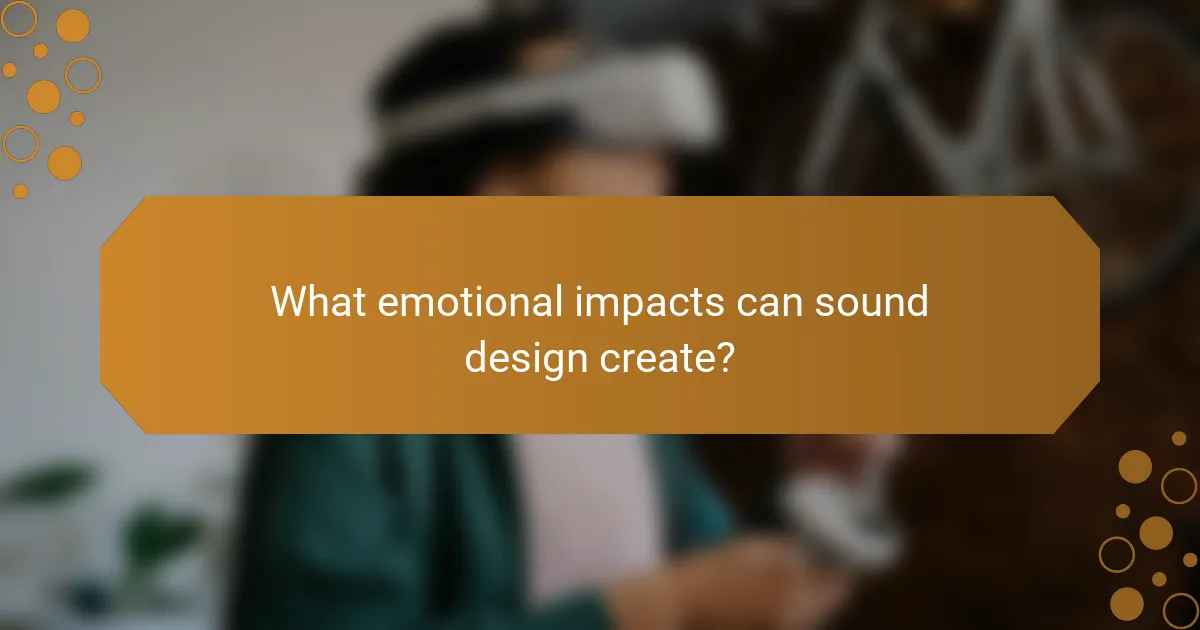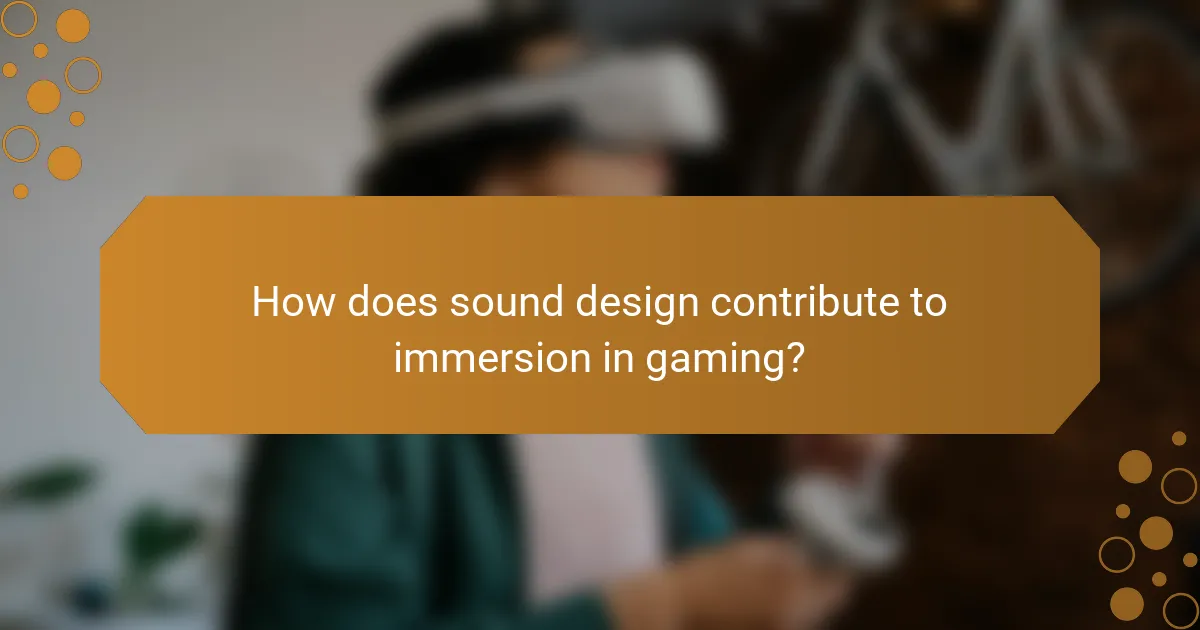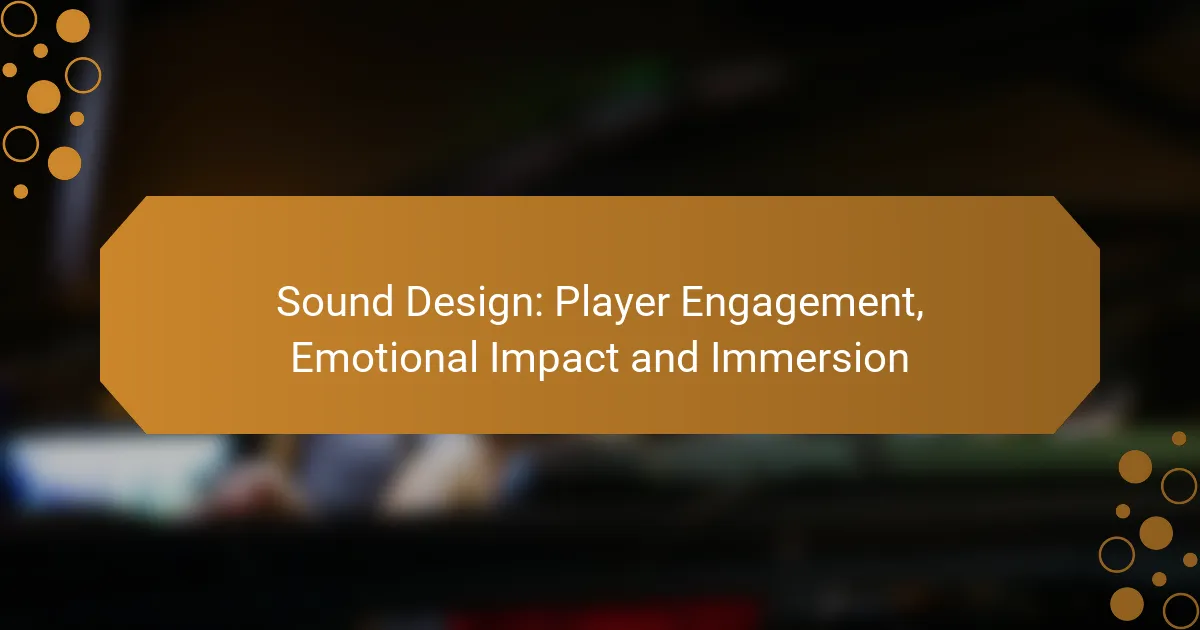Sound design plays a crucial role in enhancing player engagement by crafting an auditory landscape that complements gameplay and deepens emotional connections. By skillfully integrating audio elements, designers can evoke powerful emotions and create immersive experiences that resonate with players, drawing them further into the game world. This careful attention to sound not only enriches the narrative but also fosters a sense of presence, making the gameplay more impactful.

How does sound design enhance player engagement?
Sound design significantly enhances player engagement by creating an auditory experience that complements gameplay, evokes emotions, and immerses players in the game world. Effective sound design can draw players in, making them feel more connected to the narrative and environment.
Dynamic audio feedback
Dynamic audio feedback refers to sound effects that respond to player actions in real-time, reinforcing their choices and enhancing the overall experience. For example, a satisfying sound when a player successfully completes a task or defeats an enemy can provide immediate gratification and encourage continued play.
To implement dynamic audio feedback, consider using a variety of sound cues that match different actions. Ensure that these sounds are distinct and relevant to the gameplay context, as this helps players associate specific sounds with their actions, increasing their engagement.
Immersive soundscapes
Immersive soundscapes create a rich auditory environment that transports players into the game world. This includes ambient sounds, environmental effects, and background noise that reflect the setting, such as rustling leaves in a forest or distant city sounds in an urban landscape.
To craft effective soundscapes, layer multiple audio elements to create depth and realism. Use spatial audio techniques to position sounds in a three-dimensional space, allowing players to perceive directionality, which enhances their sense of presence and immersion.
Adaptive music systems
Adaptive music systems adjust the game’s soundtrack based on player actions or game states, creating a dynamic emotional landscape. For instance, the music might shift to a more intense score during a battle or become softer during exploration, aligning with the gameplay’s emotional tone.
Implementing adaptive music requires careful planning of musical themes and transitions. Use triggers based on gameplay events to switch between different musical layers, ensuring that the music complements the action without overwhelming the player. This approach can significantly elevate the emotional impact of the game experience.

What emotional impacts can sound design create?
Sound design can evoke a wide range of emotions, significantly enhancing player engagement and immersion in a game. By carefully crafting audio elements, designers can create experiences that resonate emotionally, heightening the overall impact of gameplay.
Heightened tension and excitement
Sound design plays a crucial role in building tension and excitement during gameplay. Techniques such as dynamic soundscapes, sudden audio cues, and escalating music can signal impending danger or critical moments, keeping players on edge. For example, increasing the tempo of background music during a chase scene can amplify the sense of urgency and thrill.
To effectively create tension, consider using dissonant sounds or silence strategically. A sudden drop in sound can create an unsettling atmosphere, making players more alert to their surroundings. Avoid overusing these techniques, as they can lose their impact if applied too frequently.
Emotional resonance through music
Music is a powerful tool in sound design that can evoke deep emotional responses from players. By aligning musical themes with character arcs or pivotal moments, designers can enhance the narrative and create lasting memories. For instance, a melancholic score during a character’s sacrifice can evoke feelings of sadness and empathy.
When selecting or composing music, consider the cultural context and emotional tone you wish to convey. Different genres and styles can elicit varying reactions; orchestral scores might evoke grandeur, while electronic music may create a sense of modernity. Ensure that the music complements the gameplay without overshadowing it.
Character voice acting effects
Voice acting significantly contributes to the emotional depth of characters in a game. Well-executed voice performances can convey a range of emotions, from joy to despair, enhancing player connection to the narrative. For example, a character’s trembling voice during a moment of fear can make the experience more relatable and immersive.
When incorporating voice acting, prioritize casting skilled actors who can deliver nuanced performances. Consider the cultural and linguistic backgrounds of your audience to ensure authenticity. Additionally, avoid excessive dialogue that may detract from gameplay; balance is key to maintaining engagement.

How does sound design contribute to immersion in gaming?
Sound design enhances immersion in gaming by creating a believable audio environment that draws players into the experience. Effective sound elements, such as ambient noises and directional audio cues, help players feel more connected to the game world and its narrative.
3D spatial audio techniques
3D spatial audio techniques allow sound to be perceived as coming from specific directions, enhancing the realism of the gaming experience. By utilizing binaural audio or surround sound systems, players can identify the location of sounds, which is crucial in action or horror games where situational awareness is key.
To implement 3D audio, developers should consider using audio engines that support spatial sound, such as FMOD or Wwise. Testing sounds in various environments can help ensure that they are positioned accurately and contribute to the overall immersion.
Environmental sound layering
Environmental sound layering involves combining multiple audio elements to create a rich soundscape that reflects the game’s setting. This can include background noises like wind, water, or wildlife, which help to establish the atmosphere and context of the game world.
When layering sounds, it’s important to balance the volume levels so that no single element overwhelms others. For instance, in a forest setting, the rustling leaves should complement the distant bird calls without drowning them out. Regularly updating and refining these layers can enhance player engagement.
Realistic sound effects
Realistic sound effects are crucial for making actions within the game feel authentic. This includes sounds for footsteps, weapon fire, and environmental interactions, which should mimic real-life sounds to enhance believability.
To achieve high-quality sound effects, developers should record real sounds or use high-fidelity libraries. It’s essential to consider the context of the sounds; for example, a gunshot in an open field will sound different than one in a narrow alley. Testing sound effects with players can provide valuable feedback on their impact on immersion.

What tools are essential for sound design in games?
Essential tools for sound design in games include software that allows for the creation, manipulation, and integration of audio. Key tools like FMOD, Wwise, and Unity Audio provide unique features that enhance player engagement and emotional impact through immersive soundscapes.
FMOD for interactive audio
FMOD is a powerful audio middleware that enables developers to create interactive sound experiences. It allows for real-time audio adjustments based on game events, enhancing immersion by adapting sound to player actions and environmental changes.
When using FMOD, consider its event-based system, which lets you trigger sounds dynamically. This can lead to more engaging gameplay, as players hear different audio cues based on their interactions. A common pitfall is overcomplicating sound events, which can lead to performance issues; aim for a balance between complexity and efficiency.
Wwise for sound integration
Wwise is another leading audio middleware that focuses on sound integration within games. It provides a comprehensive suite of tools for sound design, including mixing, sound effects, and voice management, all within a user-friendly interface.
With Wwise, you can implement adaptive audio that responds to gameplay, enhancing emotional impact. Keep in mind that Wwise’s integration with various game engines is seamless, but it requires careful planning to avoid audio clutter. Regularly test audio levels during development to ensure clarity and impact.
Unity Audio for game development
Unity Audio is built into the Unity game engine, allowing developers to manage sound directly within their projects. It offers features like audio mixing, spatialization, and effects, making it accessible for developers at all levels.
Using Unity Audio, you can create 3D sound environments that enhance player immersion. Focus on utilizing spatial audio features to position sounds accurately in the game world. A common mistake is neglecting sound layering; ensure that background sounds complement rather than overpower primary audio elements for a balanced experience.

What are the best practices for sound design in digital products?
Effective sound design in digital products enhances player engagement, emotional impact, and immersion. Best practices include maintaining consistency in audio themes, balancing sound levels, and testing audio across various devices to ensure a seamless experience.
Consistency in audio themes
Consistency in audio themes helps create a cohesive experience that resonates with users. This involves using similar sound effects, musical motifs, and tonal qualities throughout the product to reinforce brand identity and emotional responses.
For example, a game might use a specific sound palette for different environments, ensuring that players immediately recognize the setting through audio cues. This consistency can enhance immersion and make the experience more memorable.
Balancing sound levels
Balancing sound levels is crucial to prevent any audio element from overpowering others, which can disrupt user experience. Key sounds, such as dialogue or important sound effects, should be clearly audible without drowning out background music or ambient sounds.
A practical approach is to conduct regular audio mixing sessions, adjusting levels based on user feedback. Aim for a dynamic range where softer sounds are still perceptible, while louder sounds do not cause discomfort, typically keeping peaks below -6 dB in digital audio workstations.
Testing audio across devices
Testing audio across devices ensures that sound design translates well on various hardware, from high-end speakers to mobile devices. Each device may have different sound capabilities, affecting how audio is perceived by users.
To achieve optimal results, perform tests on a range of devices, including smartphones, tablets, and desktop computers. Pay attention to how audio clarity and balance change across these platforms, and make necessary adjustments to maintain a consistent experience for all users.
